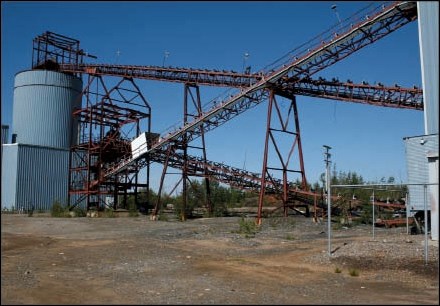Gorden Glenn is about $26 million shy of reopening a long-idle gold mine outside Flin Flon, but he hasn’t lost his optimism for the project.
The chair, president and CEO of Minnova Corp., a little-known junior miner, is banging on doors to revive interest in the former Puffy Lake mine near Sherridon.
“The project is ready to go, subject to financing, so I spend a lot of time talking to potential financiers,” says Glenn, whose company is based in Toronto.
So far Glenn has not had success, and he’s not naïve as to why. The investment market for junior miners is weak, and those who are putting up dollars tend to prefer large projects.
Puffy Lake, now known as the Maverick Gold Project, is hardly massive, but nor is it insignificant.
Based on current estimates, subject to change for better or worse, Maverick has a mine life of 10 years – 11 if you count pre-production.
During its peak production period, years 2 to 5, the mine would be expected to yield 52,522 ounces of gold a year.
Based on today’s gold prices and Minnova’s projections, the company would make about $12 million a year during that period.
Other than the anticipated earnings, Glenn says readiness is a selling point for Maverick.
Minnova anticipates the mine and accompanying mill could re-enter production 12 to 18 months after work begins.
“I can’t ask for a project, certainly a Canadian project, that can get to cash flow as quickly as the Maverick Gold Project,” Glenn says.
“Everything that we need on the project is off-the-shelf equipment, off-the-shelf technology. All of it can be sourced within Canada.”
To reach production, Maverick needs an estimated $26 million. About $10 million would refurbish the on-site mill, which Glenn says is in excellent condition and capable of processing 1,000 tonnes of ore a day.
The rest of the money would be reserved for mine dewatering and testing, underground development and contingency purposes.
Raising the requisite dollars, Glenn says, is a matter of introducing the project to would-be investors.
“Relative to other projects out there, it looks pretty attractive, but it’s really just a function of where the capital markets are right now,” he says. “I think every junior development stage project is starved for capital. So you just have to be patient, be very conscious of our current shareholder base and our current share price, and try to achieve a financing package that delivers as much value to existing shareholders and new shareholders as possible.”
Glenn says Maverick “absolutely makes sense” at the current gold price of just over US$1,200 an ounce. That’s down from the US$1,300 figure used in a preliminary economic assessment conducted last year.
The continued decline of the Canadian dollar improves the economics of the project. Since commodities are priced in US dollars, Minnova would receive more Canadian dollars for every ounce of gold produced.
But Glenn won’t accept just any offer from investors. Already he says he has turned down multiple proposals because they were too risky.
If Minnova can’t secure funding through investments, Glenn is open to going the merger and acquisition route.
“Perhaps there’s a company out there that’s looking for some growth, they’ve got some cash flow,” he says.
While he is keeping different doors open, Glenn won’t put a timeline, or even a hoped-for timeline, on the resumption of Maverick.
“Honestly I’d be guessing,” he says. “I get good feedback from guys, but most of the project finance groups out there, right now they’ve got their horns pulled in. There’s really not a lot of projects being financed, especially the smaller ones.”
From an employment perspective, the Maverick project would create an estimated 100 to 120 jobs during the construction phase of 12 to 18 months. Mining operations would need somewhere between 80 and 99 workers.
“Obviously we want to make a commitment to the First Nations up there to hire local – local First Nations, local contractors, First Nations or otherwise,” says Glenn, adding that Minnova would hire a consultant to help train the workforce.
Talk has been ongoing for several years about the possible revival of Maverick. Minnova, formerly known as Auriga Gold Corp., once hoped to resume production by the second half of 2013.
At that time the mine was projected to last only seven and a half years, with the start-up cost estimated at $18.1 million.
Maverick, located 65 km northeast of Flin Flon, produced over 28,000 ounces of gold in 1988 and 1989 before closing due to poor economics.
The Northern Miner reported that the initial owner of the mine, Pioneer Metals, built an overly large mill that jacked up operating costs and doomed the operation.




